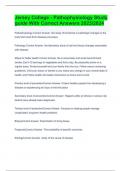Jersey College - Pathophysiology Study guide With Correct Answers 2023/2024
Pathophysiology Correct Answer the study of functional or pathologic changes in the body that result from disease processes
Pathology Correct Answer the laboratory study of cell and tissue changes associated with disease.
Steps for better health Correct Answer Be a nonsmoker and avoid second-hand smoke, Eat 5-10 servings of vegetables and fruit a day, Be physically active on a regular basis, Protect yourself and your family from the sun, Follow cancer screening guidelines, Visit your doctor or dentist is you notice any change in your normal state of health, and Follow health and safety instructions at home and at work
Primary level of preventionCorrect Answer Protect healthy people from developing a disease or experiencing an injury in the first place
Secondary level of preventionCorrect Answer Happens after an illness or serious risk factors have already been diagnosed.
Tertiary level of protectionCorrect Answer Focuses on helping people manage complicated, long-term health problems
BiopsyCorrect Answer Examination of living tissue
PrognosisCorrect Answer The probability of specific outcomes
EtiologyCorrect Answer study of the cause of disease EpidemiologyCorrect Answer The science of tracking the pattern or occurrence of disease
Latent StageCorrect Answer "silent stage" No clinical signs are evident, characterizes some diseases
Acute StageCorrect Answer Short-term that develops quickly with marked signs
Chronic StageCorrect Answer Often milder developing gradually
MorbidityCorrect Answer The disease rates within a group
MortalityCorrect Answer Indicate the relative number of deaths resulting from a particular disease
SymptomsCorrect Answer Subjective feelings, such as pain or nausea
Precipitating FactorCorrect Answer condition that triggers an acute episode (seizure)
RemissionCorrect Answer mark the course or progress of a disease; manifestations subside
ComplicationCorrect Answer new, secondary or additional problems that arise after the original disease begin
ApoptosisCorrect Answer Cell death
AtrophyCorrect Answer Decrease in the size of cells
AnaplasiaCorrect Answer cells that are undifferentiated with variable nuclear and cell structures What is gangrene?Correct Answer An area of necrotic tissue that has been invaded by bacteria.
Why does gangrene smell?Correct Answer May cause a buildup of gases with tissue and further reduce blood supply
HypertrophyCorrect Answer Increase in the size of individual cells
DysplasiaCorrect Answer cells vary in size and shape, large nuclei are frequently present
Signs & Symptoms of dehydrationCorrect Answer Dry mucous membranes, decreased skin turgor, Low BP, Low pulse, fatigue, Increased HCT, decreased mental function, confusion, and loss of consciousness
Serum Sodium Level:Correct Answer 135-145 mEq/L
Hyponatremia (low Na+ <1345 mEq/L )Correct Answer -s/s:Anorexia, nausea, cramps, fatigue, lethargy, muscle weakness, headache, confusion, seizures, decreased BP
Hypernatremia (high Na+ >145 mEq/L )Correct Answer -an excessive Na+ level in the blood & extracellular fluids
-s/s:Thirst, tongue/mucosa are dry & sticky, weakness, lethargy, agitation, edema, elevated BP
potassium level (K+)Correct Answer 3.5-5.5
Hypokalemia (low K+ <3.5 mEq/L)Correct Answer Cardiac arrhythmias, cardiac arrest, anorexia, nausea, constipation, fatigue, muscle twitch, weakness, leg cramps, shallow respirations, paresthesias, postural hypotension, polyuria, nocturia, Serum pH elevated (alkalosis)
Hyperkalemia (high K+ >5 mEq/L)Correct Answer Arrhythmias, cardiac arrest, nausea, diarrhea, muscle weakness, paralysis beginning in legs, parathesias (finger, toes, face, tongue) oliguria, Serum pH decreased (acidosis)
Hypocalcemia (low Ca++ <2.2 mmol/L)Correct Answer Tetany (involuntary skeletal muscle spasm, carpopedal spasm, laryngospasm), tingling fingers, mental confusion, irritability, arrhythmias, weak hear contractions
Normal Serum pHCorrect Answer 7.35-7.45
COPD: Acidosis or Alkalosis?Correct Answer Respiratory Acidosis
TherapeuticCorrect Answer desired action by stimulating or inhibiting cell function
IdiosyncraticCorrect Answer Paradoxic; Unexpected or unusual responses to drugs
Pain is what?Correct Answer Subjective, unpleasant sensation, feeling of discomfort resulting from stimulation of pain receptors
Referred pain with common examplesCorrect Answer Pain is perceived at a site distant
from the source; pain in the left neck and arm for heart attack or ischemia of the heart; Pain in the shoulder due to stretching of the diaphragm
Phantom painCorrect Answer Pain or another sensation such as itching or tingling after
amputation
Central PainCorrect Answer pain that is caused by dysfunction or damage to the brain or spinal cord. Ex: abscess, infarction, hemorrhage, tumor, or damage




